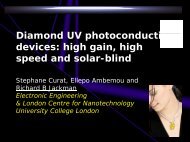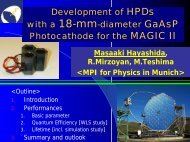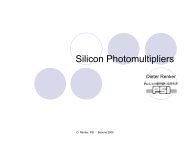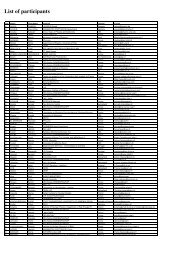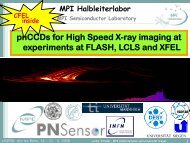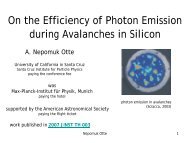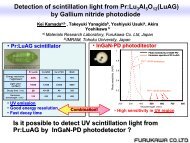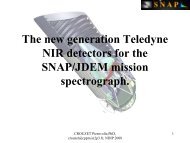Studies of the aluminum oxide based microchannel plates - NDIP 11
Studies of the aluminum oxide based microchannel plates - NDIP 11
Studies of the aluminum oxide based microchannel plates - NDIP 11
Create successful ePaper yourself
Turn your PDF publications into a flip-book with our unique Google optimized e-Paper software.
INP<br />
Development <strong>of</strong> micro-channel <strong>plates</strong> on a<br />
basis <strong>of</strong> aluminium <strong>oxide</strong>.<br />
Gleb Drobychev 1 , Andrei Barysevich 1 , Kirill Delendik 2 ,<br />
Anton Karneyeu 1 , Patrick Nédélec 3 , Daniel Sillou 3 , OlgaVoitik 2<br />
1 - Institute for Nuclear Problems, Minsk<br />
2 – Institute <strong>of</strong> Electronics, Minsk<br />
3 – Laboratory d’Annecy-le-Vieux de Physique des Particules<br />
4th International Conference on New Developments in Photodetection Beaune, France - June 19-24, 2005
Abstract:<br />
Microchannel <strong>plates</strong> (MCP) are widely used in different fields <strong>of</strong> science and technology.<br />
They have good operational parameters, such as short response time (
Microchannel <strong>plates</strong><br />
Electron Multipliers (EM) have wide range <strong>of</strong> due to <strong>the</strong>ir good characteristics such as: high<br />
gain (10 3 -10 6 ) and good operational stability. Never<strong>the</strong>less conventional EM with discrete<br />
dynodes present also some disadvantages such as: relatively poor time and spatial resolution,<br />
sensitivity to magnetic field and relatively large size.<br />
Microchannel <strong>plates</strong> (MCP) consist <strong>of</strong> a matrix <strong>of</strong> parallel <strong>microchannel</strong>s. Each one is a<br />
continuous dynode structure presenting <strong>the</strong> required resistive and secondary-emissive properties.<br />
Voltage is applied onto opposite surfaces <strong>of</strong> <strong>the</strong> plate. Incidence <strong>of</strong> primary electrons with<br />
channel walls cause an electron avalanche [1, 2].<br />
3<br />
Fig. 1. Microchannel <strong>plates</strong> (according to ref. [1, 2])
Lead glass MCP<br />
Modern MCPs are mostly produced <strong>of</strong> lead silicate glass (LSG). Their technology <strong>of</strong><br />
fabrication is <strong>based</strong> on multiplex processes <strong>of</strong> dragging and agglomeration <strong>of</strong> fibers having<br />
soluble metal or glass core resulting in production <strong>of</strong> primary multiple fibers. Agglomeration <strong>of</strong><br />
multiple fiber bundles into MCP block is performed at 570-640 °C. Afterwards <strong>the</strong> block is cut<br />
under certain angle into separate <strong>plates</strong> <strong>the</strong> surfaces <strong>of</strong> which are polished. MCP channels have<br />
hexagonal packaging, channel axis tilt is 5°-15° with respect to <strong>the</strong> perpendicular to MCP<br />
surface in order to diminish parasitic ion feedback. Conducting electrodes (chrome, nickel etc.)<br />
are sputtered on <strong>the</strong> polished surfaces. Transparency coefficient (ratio <strong>of</strong> <strong>the</strong> summary area <strong>of</strong><br />
input channel holes to <strong>the</strong> total MCP area) is about 50 - 70%. Modern MCPs have a 0.4 - 4 mm<br />
thickness, and channels diameter 10 - 100 µm, channel-to-channel distance 6 µm, resistance is<br />
about 10 9 Ohm. MCP channel length-to-diameter ratio (so called “operational aspect ratio”<br />
OAR) is in <strong>the</strong> range <strong>of</strong> 40 – 100. They have high gain (10 5 - 10 6 ); high sensitivity up to single<br />
electron mode; time resolution
Disadvantages <strong>of</strong> lead glass MCP<br />
However, lead glass MCP have also serious disadvantages mostly bound to <strong>the</strong>ir fabrication<br />
process:<br />
• Complex, labour consuming and expensive production technology;<br />
• Large parameter deviation and low reproducibility <strong>of</strong> MCP characteristics due to possible<br />
glass irregularities;<br />
• Image spottiness due to difference <strong>of</strong> <strong>the</strong>rmal histories <strong>of</strong> MCP block elements;<br />
• During MCP production <strong>the</strong> glass undergoes different influences: <strong>the</strong>rmochemical,<br />
mechanical, chemical, which lead to defects due to plate deformations caused by changes<br />
<strong>of</strong> glass composition and its temperature expansion coefficient;<br />
• Operating in strong radiation environment causes about 10 - 15% decrease <strong>of</strong> gain;<br />
• Channels with diameters less than 10 µm are impossible to produce with conventional<br />
methods and this makes it impossible to increase MCP spatial resolution;<br />
• Large area MCP are difficult to produce<br />
The development <strong>of</strong> MCP <strong>based</strong> on alternative technology, less expensive and more flexible<br />
could help in solving some <strong>of</strong> <strong>the</strong>se problems. There were many attempts to create new MCP<br />
technology during last 20 years. Different versions <strong>of</strong> <strong>microchannel</strong> structures made <strong>of</strong> glass,<br />
ceramics and o<strong>the</strong>r materials, and methods <strong>of</strong> conductive and secondary emissive layers creation<br />
are proposed. But in spite <strong>of</strong> an abundance <strong>of</strong> publications, a new MCP technology, able to<br />
concurrence <strong>the</strong> existing one did not emerge.<br />
5
Anodic aluminium <strong>oxide</strong> as a material for MCP production<br />
Recently, anodic aluminium <strong>oxide</strong> (AAO) was proposed as a possible way for MCP<br />
production. AAO is a dielectric material consists <strong>of</strong> hexagonal packed cells, parallel to one<br />
ano<strong>the</strong>r each o<strong>the</strong>r and perpendicular to <strong>the</strong> surface <strong>of</strong> aluminium substrate. Each cell has axial<br />
pore, closed by a <strong>oxide</strong> layer barrier on <strong>the</strong> side <strong>of</strong> <strong>the</strong> aluminium substrate. The cell diameter is<br />
mainly a function <strong>of</strong> <strong>the</strong> anodization voltage. Diameter <strong>of</strong> <strong>the</strong> pores depends on <strong>the</strong> nature <strong>of</strong> <strong>the</strong><br />
electrolyte, and several parameters <strong>of</strong> <strong>the</strong> anodization process. The adjustment <strong>of</strong> <strong>the</strong>se<br />
parameters maybe used to to adjust <strong>the</strong> dimensions <strong>of</strong> <strong>the</strong> cells and pores. Also a selective<br />
etching <strong>of</strong> cell walls can enlarge pore diameter [3, 4].<br />
6<br />
2 µm 3 µm 3 µm<br />
a b c<br />
Fig. 2. Anodic aluminium <strong>oxide</strong>. a – porous side, b- barrier layer, c - side view.
Advantages <strong>of</strong> <strong>the</strong> AAO MCP<br />
The technology <strong>of</strong> AAO production, which includes a deposition <strong>of</strong> <strong>oxide</strong> films with suitable<br />
properties on <strong>the</strong> walls <strong>of</strong> <strong>the</strong> MCP channels was developed [5 - 7]. A deposition <strong>of</strong> films with<br />
<strong>the</strong> required electrophysical properties allows to modify <strong>the</strong> conduction and secondary electron<br />
emission properties <strong>of</strong> <strong>the</strong> AAO MCP.<br />
In comparison with conventional technology, <strong>the</strong> proposed one will have several advantages:<br />
• The use <strong>of</strong> standard microelectronics technology at all stages <strong>of</strong> MCP production (from<br />
<strong>plates</strong> growth up to production <strong>of</strong> operational MCP) will allow to lower every costly aspect<br />
<strong>of</strong> <strong>the</strong> production process.<br />
• The formation <strong>of</strong> <strong>microchannel</strong> structure by batch technology (instead <strong>of</strong> individual<br />
treatment <strong>of</strong> fibres), will raise product yield and reproducibility <strong>of</strong> MCP parameters;<br />
• The possibility to produce MCP with channel density up to 10 10 cm -2 and diameter 0.1 µm<br />
and higher. This will provide higher spatial resolution <strong>of</strong> MCP on <strong>the</strong> base <strong>of</strong> anodic alumina<br />
in comparison with conventional MCP on <strong>the</strong> base <strong>of</strong> lead-silica glass;<br />
• The possibility to produce <strong>of</strong> MCP with any necessary aspect ratio up to 600;<br />
• Thickness up to 50 – 200 µ (up to 500 µm with special technological methods),<br />
• Ratio between surface <strong>of</strong> channels and surface <strong>of</strong> plate is up to 50 % without significant loss<br />
<strong>of</strong> mechanical hardness.<br />
7
• Diameter <strong>of</strong> channels can vary from 10 nanometers up to several micrometers,<br />
• Possibility to increase MCP area up to 5×5 cm and probably even up to 8×8 cm.<br />
• Working temperature from – 200 to + 500 degree;<br />
• Low sensitivity to strong magnetic fields;<br />
• Extremely high radiation hardness.<br />
• Possibility to implant by special technology means atoms <strong>of</strong> lead into <strong>the</strong> MCP structure in<br />
order to increase MCP stopping power;<br />
Parameters and characteristics <strong>of</strong> AAO MCP are impossible to obtain by production methods<br />
<strong>of</strong> conventional LSG MCP. These advantages extend <strong>the</strong> field <strong>of</strong> application <strong>of</strong> <strong>microchannel</strong><br />
multipliers noticeably. Industrial implementation <strong>of</strong> such technology will allow to decrease<br />
labour-intensiveness, material consumption and costs in dozens <strong>of</strong> times.<br />
One can expect that <strong>microchannel</strong> electron multipliers on <strong>the</strong> base <strong>of</strong> anodic <strong>aluminum</strong> <strong>oxide</strong><br />
are able to replace conventional MCPs in all fields <strong>of</strong> <strong>the</strong>ir current application, as well as in o<strong>the</strong>r<br />
fields where application <strong>of</strong> conventional MCPs is limited now by shortcomings <strong>of</strong> existing<br />
technology.<br />
8
Simulation <strong>of</strong> <strong>the</strong> AAO MCP detection efficiency<br />
Simple analysis shows that single anodic alumina MCP have very small detection efficiency for<br />
<strong>the</strong> gamma with energies higher than 100 keV. A prototype <strong>of</strong> calorimeter for registration <strong>of</strong><br />
gamma radiation with energy up to 1 MeV have to have special design, for example as described<br />
in [8, 9]. A series <strong>of</strong> simulation with GEANT 4 simulation package were carried out. The<br />
simulated detectors on a basis <strong>of</strong> MCP are shown in Fig. 3 a, b.<br />
9<br />
Fig 3 a. Single MCP<br />
e - ,γ MCP<br />
Absorber<br />
Fig.3 b. Sandwich design<br />
γ
Registration efficiency, rel.un.<br />
1<br />
0.1<br />
0.01<br />
0 200 400 600 800 1000<br />
Ee-, keV<br />
Simulation results (single MCP)<br />
40 мкм<br />
50 мкм<br />
100 мкм<br />
Registration efficiency, rel.un.<br />
1.E+00<br />
1.E-01<br />
1.E-02<br />
1.E-03<br />
1.E-04<br />
1.E-05<br />
40 мкм<br />
50 мкм<br />
100 мкм<br />
0 200 400 600 800 1000<br />
Eγ, keV<br />
Fig. 4. Registration efficiency for electrons (a) and gamma (b) for single AAO MCP <strong>of</strong><br />
different thickness.<br />
As one can see single MCP is efficient for electrons and X-rays registration, but inefficient<br />
for registration <strong>of</strong> gamma with energy higher than 30 keV.<br />
10
Registration efficiency, rel.un.<br />
1<br />
0.1<br />
0.01<br />
0.001<br />
0.0001<br />
10 100 1000 10000<br />
Energy <strong>of</strong> gamma, keV<br />
Simulation results (sandwich MCP)<br />
Al<br />
Be<br />
Mg<br />
Registration efficiency, rel.un.<br />
0.01<br />
0.001<br />
0.0001<br />
0.00001<br />
10 100 1000 10000<br />
Energy <strong>of</strong> gamma, keV<br />
Fig. 5. Registration efficiency for gamma for sandwich AAO MCP (100 mkm thickness)<br />
and different metal absorbers (thickness <strong>of</strong> each metal plate is 0.5 mm).<br />
Among simulated beryllium looks <strong>the</strong> best for <strong>the</strong> energy region from 0 to 70 keV and<br />
copper is preferable for region after 50 keV.<br />
<strong>11</strong><br />
Ag<br />
Pb<br />
Cu<br />
W
Research Programme<br />
- To develop a technology <strong>of</strong> deposition <strong>of</strong> regular homogenious conductive and emissive<br />
coatings <strong>of</strong> with controllable electrophysical properties and good adhesion to <strong>the</strong> walls <strong>of</strong> deep<br />
narrow channels.<br />
- To produce series <strong>of</strong> MCPs prototypes with different thickness, aspect ratio and size, and<br />
supplementary secondary emissive coatings (if <strong>the</strong> necessity will be found).<br />
- To make regular research <strong>of</strong> MCP with various parameters in order to find <strong>the</strong>ir optimal<br />
combinations, which will provide <strong>the</strong> best electrophysical characteristics <strong>of</strong> MCP for different<br />
particular applications. The MCP amplification coefficient versus voltage, timing response<br />
(jitter), and MCP response to electrons excitation will be measured for single MCPs and<br />
sandwich on a basis <strong>of</strong> MCPs.<br />
- To develop technology means to implant atoms <strong>of</strong> lead into <strong>the</strong> MCP structure in order to<br />
increase MCP stopping power.<br />
12
13<br />
Setup
14<br />
-V<br />
-V+ 200<br />
-V+ X1<br />
-V+ X2<br />
A1<br />
A2<br />
Schema <strong>of</strong> measurements<br />
Vacuum chamber<br />
MCP<br />
Anode<br />
Thermoemitter<br />
Hea ter<br />
A3<br />
X1 = 400 – 1200 V,<br />
X2 = 200 – 1600 V
Measurements results<br />
First experimental MCPs:<br />
Type Thickness, µm Diameter <strong>of</strong> channel, nm<br />
1<br />
40 70<br />
2<br />
190 100<br />
3<br />
40 100<br />
4<br />
190 8000<br />
Resistance depending <strong>of</strong> thickness from tens to hundreds MOhm.<br />
Volt-ampere characteristics <strong>of</strong><br />
Type 1 MCP:<br />
15<br />
Current, A<br />
5,00E-07<br />
4,50E-07<br />
4,00E-07<br />
3,50E-07<br />
3,00E-07<br />
2,50E-07<br />
2,00E-07<br />
1,50E-07<br />
1,00E-07<br />
5,00E-08<br />
0,00E+00<br />
0 200 400 600 800 1000 1200 1400<br />
Tension, V
References:<br />
1. Joseph Ladislas Wiza. Microchannel plate detectors. Nuclear instruments and methods 162 (1979) 587-<br />
601.<br />
2. P.M. Shikhaliev. Hard x-ray detector <strong>based</strong> on <strong>microchannel</strong> <strong>plates</strong>. Rev. Sci. Instrum., Vol. 67, No. 3,<br />
March 1996<br />
3. O. L. Voitik, K. I. Delendik. Anodic alumina as a material for MEMS // Proceeding <strong>of</strong> SPIE 2001<br />
International Symposium on Microelectronics and Micro-Electro-Mechanical Systems (MICRO/MEMS<br />
2001). 17-19 December 2001, Adelaide, Australia 7 pp<br />
4. Delendik K. I., Voitik O. L. Anodic alumina as material for high-aspect ratio microstructures //<br />
Proceeding <strong>of</strong> Fourth International Workshop on High-Aspect-Ratio Micro-Structure Technology. June<br />
2001. Baden-Baden, Germany. 2pp.)<br />
5. A.S. Kurilin, V. N. Kukhnovetc, I. F. Emel'yanchik and o<strong>the</strong>rs. Sub<strong>microchannel</strong> plate multipliers //<br />
Applied Surface Science. <strong>11</strong>1 (1997) Ð.295-301<br />
6. A.S. Kurilin, A. N. Govyadinov, I. F. Emel'yanchik. Anodic <strong>aluminum</strong> <strong>oxide</strong> <strong>microchannel</strong> <strong>plates</strong> //<br />
Nuclear Instruments and Methods in Physics Research A 419 (1998) 667-675.<br />
7. Emeliantchik I.F., Rumiantsau V.S. et.al. Development and creation <strong>of</strong> new types <strong>of</strong> detectors and readout<br />
electronics for modern and future experiments in particle and high energy physics. Selected scientific<br />
papers <strong>of</strong> BSU, Minsk-2001, p.303-322.<br />
8. Generalized hard x-ray detection model for <strong>microchannel</strong> plate detectors, P. M. Shikhaliev, A. F. I<strong>of</strong>fe,<br />
Physical-Technical Institute, Bogaychuka street 24-40, 189631, Metallostroy, St. Petersburg, Russia Rev.<br />
Sci. Instrum. 68 (10), October 1997<br />
9. P.M. Shikhaliev. A new hard X-ray detector <strong>based</strong> on <strong>microchannel</strong> <strong>plates</strong>. Nuclear Instruments and<br />
Methods in Physics Research A 379 (1996) 307-3<strong>11</strong>.<br />
16



